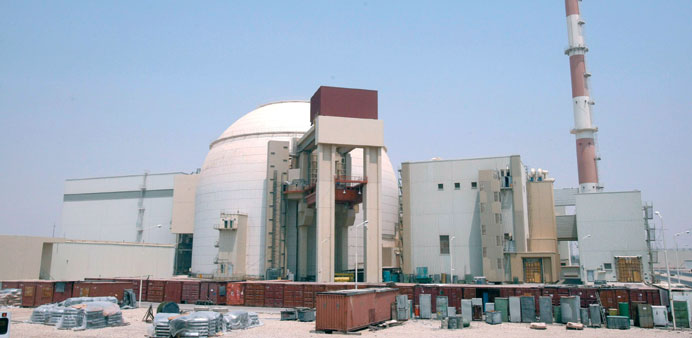|
The Gulf Co-operation Council yesterday called for international inspectors to be sent to Iran’s Bushehr nuclear plant over concerns of possible radiation leaks after an earthquake hit the area. |
The body demanded the International Atomic Energy Agency (IAEA) “send a specialised technical team to inspect the Bushehr nuclear plant and investigate potential damage”, GCC chief Abdullatif al-Zayani told an emergency meeting of top Gulf officials.
A 6.1 magnitude quake hit Iran on Tuesday at a depth of 12km in the area of Kaki, according to the Iranian Seismological Centre.
Zayani said the earthquake would “sound alarm bells over the safety of a nuclear plant situated in an area with high seismic activity”, urging Iran to commit to international safety standards.
Zayani warned officials at the meeting in Riyadh of the “deep concern among GCC states and the international community about the potential risk that any damage to Iran’s nuclear plant could cause radiation leaks”.
GCC states had already “warned that radiation leaks from Bushehr plant could have damaging effects on the natural environment in the Gulf region”, he said.
The quake killed 37 people and injured 850 others, Iranian authorities said.
Zayani said the six Gulf Arab states have previously urged Tehran to ensure its facility complies with international safety standards and join the Convention on Nuclear Safety, but Tehran did not show any sign it understood international concerns over its nuclear programme.
Iran is the only country operating a nuclear power plant that does not belong to the convention, negotiated after the 1986 nuclear disaster in Chernobyl which contaminated a wide area and made 160,000 Ukrainians homeless.
Iran said it informed the IAEA there had been no damage to the nuclear power plant in Bushehr, nearly 90km northwest of the earthquake’s epicentre.
Iran’s atomic chief Fereydoon Abbasi-Davani said that the power plant was not operational when the quake struck as it was “under maintenance”, Iranian media reported.
The Bushehr plant has yet to become fully operational, as its construction has suffered a number of delays and setbacks.
Tehran has repeatedly rejected safety concerns about Bushehr, which is located in a highly seismic area on Iran’s Gulf coast.
Abbasi-Davani said hours after the earthquake that more reactors would be built there.
The Bushehr site is capable of holding six power reactors and construction of two more units of at least 1,000 megawatts will start in the “near future” there, he said. Iran has identified 16 sites elsewhere in the country suitable for other atomic plants.
Iran sits on major faultlines and has suffered several devastating earthquakes, including a 6.6-magnitude quake in 2003 which flattened the southeastern city of Bam and killed more than 25,000 people.



